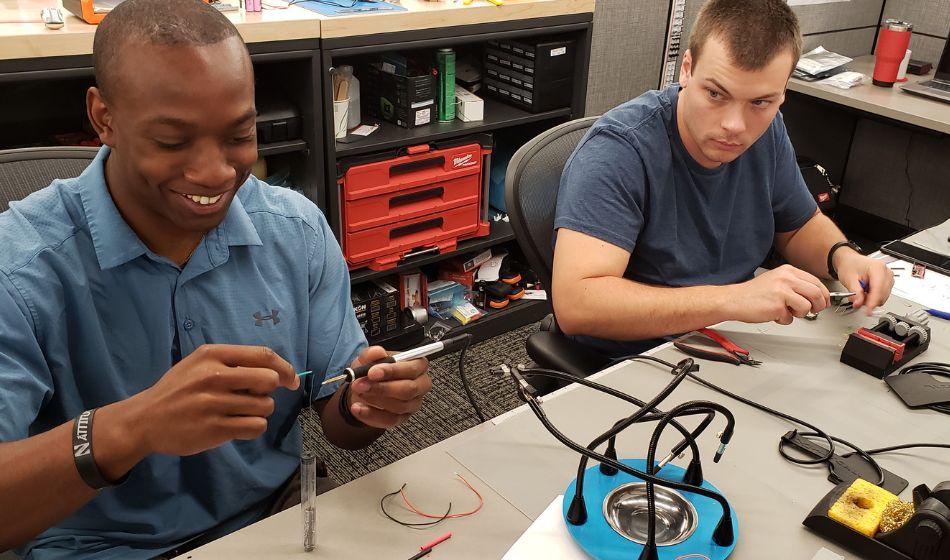Whether football helmet or safety helmet, this Concept Engineer’s “Play-to-Win” spirit is creating a bright career.
It’s June 2022 and it’s Jesse Brown’s first day as a Concept Engineer at Milwaukee Tool. He spent his morning at our Global Headquarters in Brookfield, Wis., immersing himself in the Day One orientation, and just got off the shuttle at his primary workplace – our new downtown Milwaukee location. He stands in his office, arms full of orientation materials and IT supplies, and looks around. This is his first full-time job and, while excited at the prospect of continuing to hone his design engineering skills here, he is admittedly a little nervous – would he measure up? Would he ultimately feel welcomed at this fast-growing global company on the brink of nearly $8 billion in sales?
Jesse’s manager walks in. “I’d like you to join us for a brainstorming session, if you’re up for it,” he says.
Jesse is stunned. He hasn’t even been here a full day – being asked to participate in a team brainstorming session wouldn’t have been first on his list of activities he thought he’d get to take part in this early.
Jesse’s manager leads him to a collaborative conference room where nearly a dozen other employees are gathered – design researchers, concept leads, and concept engineers. The topic of discussion? The PACKOUT™ Modular Storage System, one of the company’s most popular solutions.
Within minutes Jesse isn’t just listening to the team members discuss ideas for design enhancements – he’s being encouraged to actively share his opinions as well!
“It was pretty cool to be able to contribute at that level on my first day. The experience also put me at ease,” says Jesse. “It didn’t matter that I was brand-new. I was hired because [Milwaukee] knew I had unique skills, and they wanted me to contribute no matter how green I was.”
It’s exactly this type of “One Team Mentality” – building on the different strengths and perspectives of everyone no matter their level or background – that has continued to empower Jesse in his short time so far at Milwaukee Tool.
In fact, problem-solving and teamwork have been consistent themes in Jesse’s life for quite some time – whether in the lab or on the football field.
Running Down a Future in Human-Centered Design

From a young age, Jesse has been drawn to two things:
- Creating and building. Whether it was constructing houses with building blocks in pre-K, to physics experiments in high school, Jesse has always been naturally curious.
- Playing Football. The youngest of 3 boys in his family, he followed in their footsteps playing recreationally – first as an offensive tackle and eventually as a running back.
Ultimately, both these interests led Jesse to Northwestern University, where he was able to pursue an undergraduate degree in Mechanical Engineering (followed by a master’s) while balancing his time on the football field through a scholarship.
After exploring different facets of engineering through an array of classes, Jesse started to find himself drawn to a problem-solving technique that puts real people at the center of the engineering development process: human-centered design. Throughout a 10-week course, he was assigned a client through the university’s partners, explored the problems they were facing, built out their user needs, and created a product or process to satisfy those needs.
Meanwhile, he took a job in the 3D printing lab, handling printing requests for research groups, classes, partners, and more. His favorite requests came from the local medical school, which frequently ordered 3D-printed infant rib cages for student CPR trainings.
While Jesse was still very much committed to the technical side of Engineering, it was becoming clear with each passing day that the ‘design’ side was really the area he felt most drawn to.
"I wanted to actually talk to the people who were going to be using what I helped design and develop. That’s what mattered to me most – the interaction with, and impact on, the user,” said Jesse.
Soon he was 20 weeks deep into a thesis project for his master’s in design, developing a device that could be used in physical therapy to offer seamless instruction to the patient whether in the clinic or at home.
He had laid the foundation for where he wanted to go with his career – design engineering to create products that enhance people’s lives.
Now, he just needed to find a place where he could live that out in a meaningful way.
Playing to Win (For the Users)
Milwaukee Tool wasn’t on his radar initially, but after a networking event at Northwestern, he got acquainted with an alumnus from his master’s degree program who got him intrigued about concept engineering at our fast-growing company.
“It felt like a good fit – a pretty close 1-to-1 with what I wanted to do [human—centered design],” said Jesse. “So, I applied.”
From application through interviews, it all moved quickly, and, within the span of just a few days, Jesse was extended an offer to join the Milwaukee® team.
About a month from starting, Jesse got another piece of news – in his role, he’d perform concept engineering for our Personal Protective Equipment (PPE) solutions (e.g., safety vests, hearing protection, hard hats, helmets, safety glasses.)
His initial reaction?
“I thought it was going to be pretty boring,” he said.
Boy was he wrong.
Scoring Touchdowns for Jobsite Safety
Soon after his first day, when he got to lend his insights and opinions to a PACKOUT™ brainstorming session, Jesse was trading in his football cleats for steel-toed boots and traveling across the country to do jobsite research. His goal: to observe and work with users in the professional trades (e.g., general contractors, electricians, plumbers) to better understand their frustrations and needs with current PPE offerings so he and his team can design, evaluate, and potentially implement new concepts to solve those issues.
“[Personal Protective Equipment] is a relatively newer space for Milwaukee®, and I’ve come to find that it’s a space that has a ton of opportunity,” he says. “What’s available for users hasn’t been improved on in decades.”
While doing jobsite research, Jesse gets to do something he loves: talk directly to the people he’s going to impact.
“I get to watch these people do their jobs. Talk to them about what they encounter every day. Discover their pain points,” he says. “Then I get to go back to the office, concept a solution, design a prototype with the team, and bring it back to those users to try out. It’s pretty gratifying.”
Within his first 4 months on the team, Jesse also got to attend a national safety conference on behalf of Milwaukee Tool, just because he showed an interest in continued learning and research into PPE.
“At the time I didn’t know a ton about the trades or safety products, so I felt this would be a good opportunity to get more context on what I was designing and who I was designing for,” he says.
Alongside some individuals from our leadership team, Jesse and one of the other design researchers spent their time walking up and down the booths taking in as much information as they could. Once they returned from the conference, they got the chance to prepare a report and present to the rest of the PPE team about what they learned and opportunities that could be implemented in Milwaukee® solutions.
Meanwhile, Jesse continued to receive dedicated training and development support that helped him set clear goals and, ultimately, get listed on three patents in less than a year.
He continues to get excited about the opportunities ahead of him and the team to keep users safe and productive.
Advances in smart technology are creating new opportunities to enhance PPE and protect users. As Milwaukee Tool continues to leverage emerging technologies to make our power tools smarter, Jesse notes that these same techniques could be used to make PPE smarter.
“Some of our newest power tools are being developed with machine learning, providing additional control and features for users. Think about the capabilities we could deliver doing similar with PPE,” he says. “We [Milwaukee Tool] could provide some true change for users. Change that could even impact current standards on jobsites and improve the overall future of the trades.”
Jesse’s Biggest Takeaways from his First Year at Milwaukee®
- Resources are never far away. If you need something (new equipment, software, training, etc.) to help you innovate for Milwaukee’s users, make the case for it and, chances are, you’ll get it.
- Your expertise matters from day one. Just as Jesse experienced his first day, no matter your role or tenure, you have a seat at the table. In fact, part of Jesse’s job is to help consult management on what to move forward on, and what not to. The ‘noes’ are just as important as the ‘yeses,’ and leadership listens.
- Collaboration drives everyone at every moment. Jesse likes how coming to work feels like “hanging out.” It’s an environment that’s encouraging, with space to explore and do what you need to develop your products and yourself. Everybody is trying to help everybody else.



